Self-propelled lawn mowers are a time-saving option for anyone who needs to mow a large lawn.
In this guide, we’ve shared everything you need to know about self-propelled mowers, including how they work, how they compare to conventional mowers, their pros and cons, and more.
✅Key Takeaways:
Self-propelled lawnmowers have a special vehicle-like drive system that propels them forward without the need for physical pushing.
These mowers work by driving the front wheels, back wheels, or all four wheels forward when you engage the self-propulsion bar. Some mowers have a set speed, while variable speed models allow you to adjust the forward speed.
Self-propelled mower models are time- and labour-saving and make easy work of inclines and thick grass on large lawns, but they’re more expensive than conventional mowers, and are impractical for small lawns.
Table of Contents
🤷♂️ How Does A Self-Propelled Lawn Mower Work? Quick Overview
A self-propelled lawn mower drives itself forward with a self-propulsion function, so the user doesn’t have to push it manually. The mower is operated like any other push mower, but rather than physically pushing the mower, you simply walk behind it and hold onto the handles as it moves forward independently.
🧐 What Is A Self-Propelled Lawn Mower?
A self-propelled lawn mower is a wheeled push mower with a self-propulsion system.
Self-propelled mowers are specifically designed to make lawn mowing faster, easier, and more efficient because they have a drive system that connects the engine or motor to the wheels, turning the wheels without the need for the user to push the handles.
You can find self-propelled mowers with several different power sources. Petrol self-propelled lawn mowers are the most commonly available option because a petrol engine is the most powerful option for long-distance mowing. Some cordless mowers also have self-propulsion. Best self-propelled petrol mower guide.
Self-propulsion isn’t a guaranteed feature on all lawn mowers. You’re most likely to find it on larger mowers with cutting widths of 46cm or wider. Expect to pay around 30% more for a mower with self-propulsion than you would on a comparable mower without this feature.
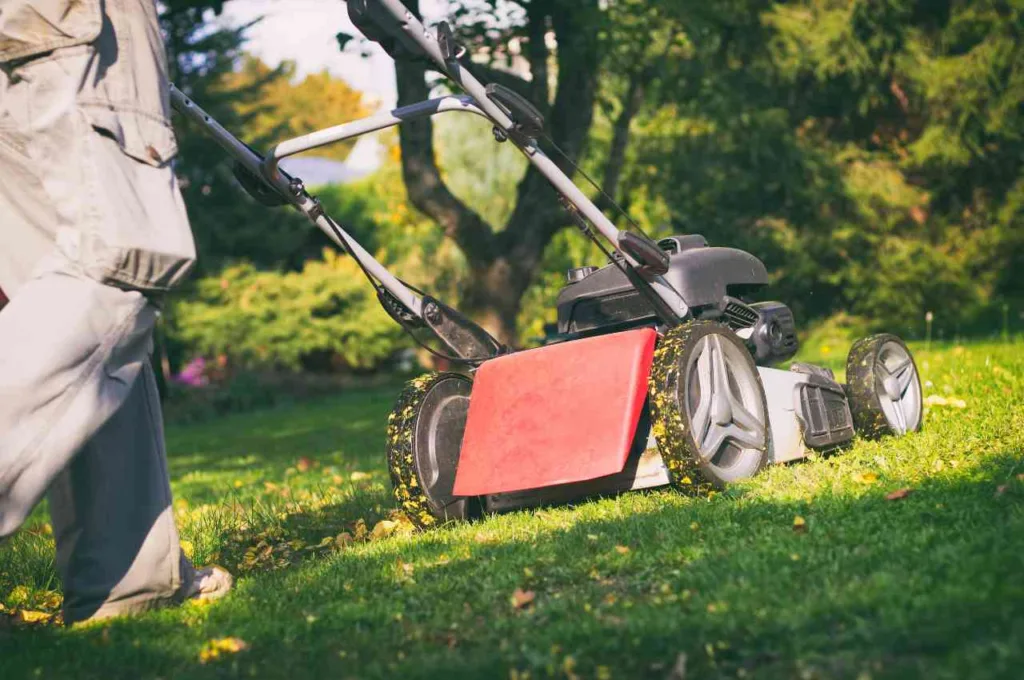
⚙️ How A Self-Propelled Lawn Mower Works
Self-propelled lawn mowers have a motor or engine that powers their blades, just like any conventional lawn mower.
The feature that makes these mowers unique is that their motors or engines also power a drive system that turns the wheels, allowing them to move forward without physical pushing from the operator.
There are several different drive systems for a self-propelled lawn mower, including front-wheel drive, rear-wheel drive, and all-wheel drive. We’ve discussed these in more detail below.
Some self-propelled lawn mowers have a single self-propulsion speed, which is usually a brisk walking speed. More advanced self-propelled mower models allow you to adjust the speed controls to suit your walking pace.
A self-propelled lawn mower will only operate when the self-propulsion bar or lever is engaged. This means you’re not completely mowing on autopilot (which would increase the risk of accidents). If you need to stop the mower from moving forward, you can simply stop pressing on the self-propulsion bar.
🤔 Different Self-Propelled Lawn Mower Drive Options
The three different drive systems for a self-propelled lawn mower are:
Front-wheel drive – In a front-wheel drive mower, the power from the engine or the motor is transferred to the front wheels. Front-wheel drive mowers are easier to manoeuvre, making them a good option for lawns with lots of tight spots or obstacles. However, they don’t perform as well on slopes, when the weight of the mower is concentrated at the rear, so they’re best for flat and even terrains.
Rear-wheel drive – In a rear-wheel drive mower, the motor or engine power is transferred to the rear wheels. Rear-wheel drive mowers provide better traction on hilly terrain, and they offer better stability and control than front-wheel drive mowers. However, they’re slightly less manoeuvreable and may struggle around tight corners.
All-wheel drive – In a four-wheel drive or all-wheel drive mower, the engine or motor power is transferred to all four wheels on the mower, front and back. This mower gives the best of both drive types, with excellent traction on flat lawns and hilly terrain, and increased control and stability during mowing. The setback of four-wheel drive is that it costs more than the other two drive system types.
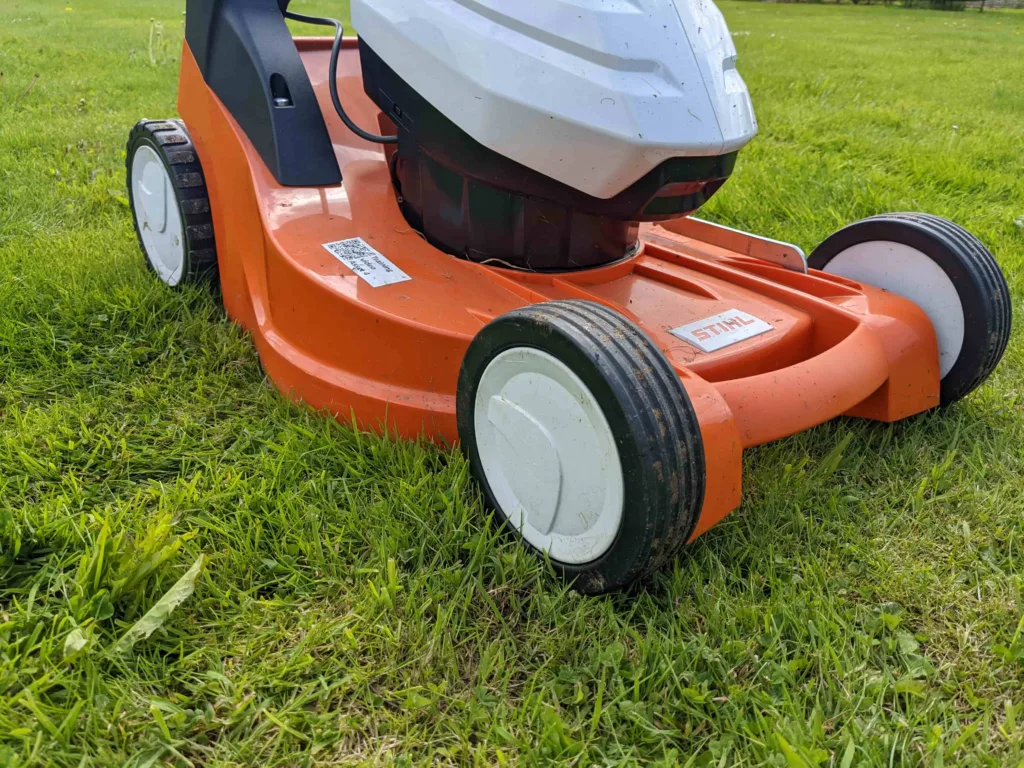
 How Do You Start A Self-Propelled Mower?
How Do You Start A Self-Propelled Mower?
You start a self-propelled lawn mower in the same way that you’d start any traditional push mower. The only difference is that you will also need to engage a push bar or lever to operate the self-propulsion.
The exact starting method depends on the type of mower you own.
To start a self-propelled cordless lawn mower, follow these steps:
Make sure the battery is charged and inside the mower.
Press the start lever or button to start the motor.
Push the self-propulsion bar against the handlebar to drive the wheels forward.
Best self-propelled cordless mower guide.
To start a self-propelled petrol lawn mower, follow these steps:
Make sure the mower has plenty of fresh petrol and oil.
Pull the throttle to starter position and pull the starter cord to start the mower engine. Note: if your petrol mower is electric start, you can start the mower by pressing a button.
Push the self-propulsion bar against the handlebar to drive the wheels forward.
The exact instructions for starting a self-propelled mower depend on your model. Make sure to check instructions in your user manual if you’re starting the mower for the first time or you need a reminder on how to start.
🔧 How To Adjust Self-Propulsion Speed On Mower
Not all self-propelled mowers allow you to adjust the speed of self-propulsion.
However, if your mower does have variable speed control, here are a few different ways to adjust your mower’s drive speed:
🏍 Adjust The Speed Control Lever
Many self-propelled mowers have a speed control lever or drive lever on the handle. You can adjust the mower’s speed by moving the lever forward or backward.
Depending on your mower, you might have the option to adjust the speed across a continuous range, or there might be several pre-set speed settings (e.g., slow, medium, fast).
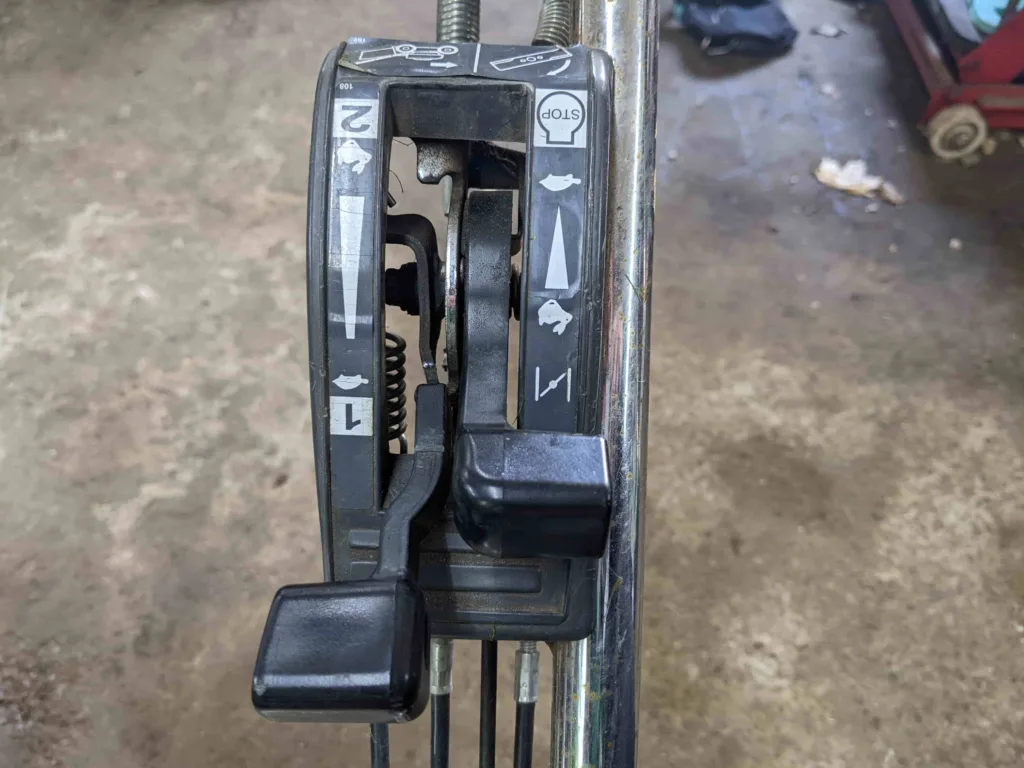
⬇️ Increase/Decrease Pressure On The Drive Bar
Other self-propelled lawn mower models have a drive bar that’s connected to the mower handlebars. You’ll need to squeeze the bar towards the handle to operate the mower.
The more pressure you put on the drive bar, the faster the mower will go. Reducing pressure on the drive bar will reduce your speed.
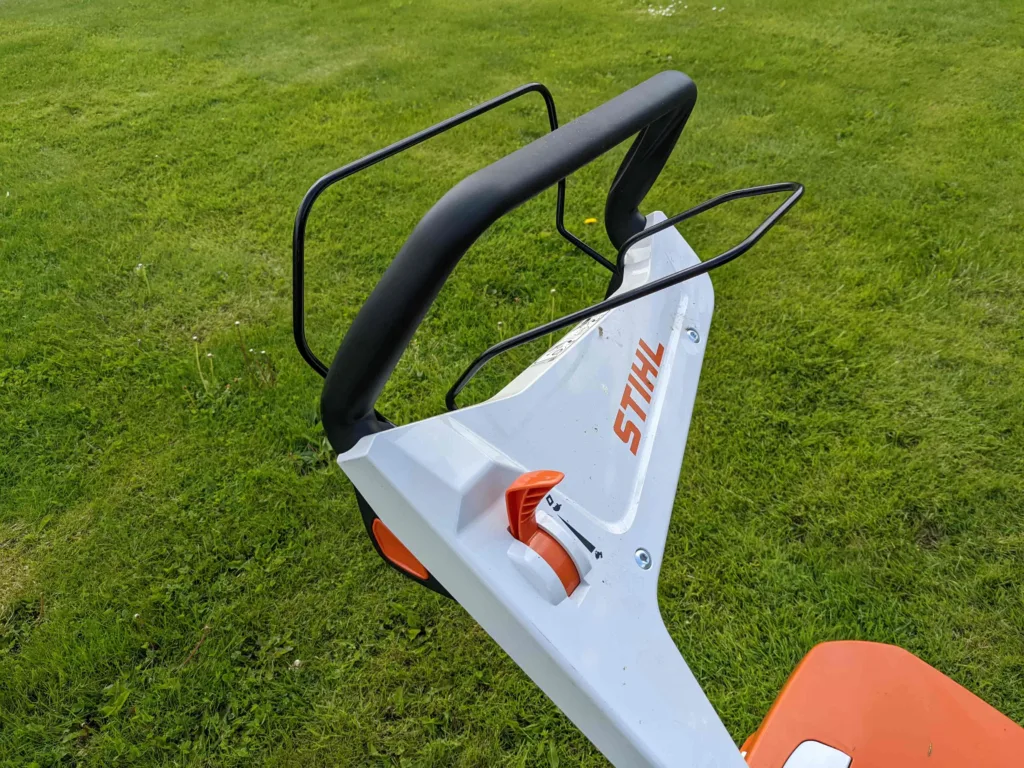
🧰 Adjust The Throttle Lever
If you want to increase the speed of your self-propelled petrol mower beyond the maximum preset speed, you can do this by “cheating” with the throttle.
Use a screwdriver to loosen the screw on the throttle housing, allowing the lever to pop out slightly, giving more distance between it and the handlebar. This will generate more power to the engine, so the mower can move faster.
Make sure to tighten the screw on the throttle housing once the lever has been adjusted to its new position.
🤨 How To Use A Self-Propelled Mower: Step-By-Step
Using a self-propelled push mower is very similar to using any other manual push lawn mower. You still have to steer and operate the mower, but you don’t have to physically push the mower forward.
Here’s a quick step-by-step on how to use a self-propelled mower:
Switch the mower on. If you have a petrol mower, prime the engine and pull the starter cord. If you have a battery mower, press the “start” button or engage the start lever while holding the safety switch.
Engage the self-propulsion. Squeeze the self-propulsion bar against the mower handle to engage the self-propelled drive. If your mower doesn’t have a self-propulsion bar, check your user manual for instructions.
Mow your lawn. Collect, disperse, or mulch your grass clippings depending on your preferences and your mower’s features. You won’t have to push the mower – just keep it on the right path and turn it after each lap.
Clean the mower. Once you’ve finished mowing, switch off the engine/motor and clean the cutting blades, removing clumps of grass and dirt.

🤼♀️ Self-Propelled Mowers Vs Manual Push Mowers
Self-propelled lawnmowers are easier and faster to use than manual push mowers, but they’re not suitable for all situations.
Using a self-propelled lawn mower can help you to mow large spaces faster and with less effort. With a self-propelled mower, it doesn’t matter whether you’re cutting uneven terrain, tall grass, or hilly land – you won’t have to put in more effort because the mower moves forward without your input.
However, self-propelled mowers cost around 30% more than comparable standard push mower models, and they’re not practical for smaller gardens, where manoeuvrability and easy turning are more important features of a lawn mower.
✅ ❌Pros & Cons Of Self-Propelled Mowers
Let’s take a quick look at the pros and cons of self-propelled lawn mowers:
✅ Self-Propelled Mower Pros
Easier To Use
The biggest advantage of self-propelled mowers is that they’re a lot easier to use than conventional push lawn mowers. The self-propelled drive eliminates the need to exert energy pushing the mower, so mowing is less physically demanding and more accessible.
Quicker
Using a self-propelled lawn mower on a large lawn allows you to mow much faster than you would with a push mower. You can maintain a consistent speed regardless of the terrain you’re mowing on – whether you have a flat lawn or sloped garden.
Versatile
You can buy petrol mowers and battery-powered mowers with self-propulsion, so you don’t just have one power source to choose from. Different self-propelled mowers also have a range of different cutting widths and features, so there’s something for everyone.
❌ Self-Propelled Cons
Self-Propulsion Costs Extra
You pay around £50-£90 extra for a mower with self-propulsion, and you may not be able to justify the additional upfront spend.
Can’t Always Control Drive Speed
Some self-propelled mowers only have a single speed option. If you’re an older person or you like to take your time when you’re mowing, this speed might be too fast for you.
Heavier
Self-propelled mowers are heavier than conventional push mowers because of the extra weight of the self-propulsion drive system. You may find it more difficult to get the mower in and out of storage and perform certain maintenance tasks.
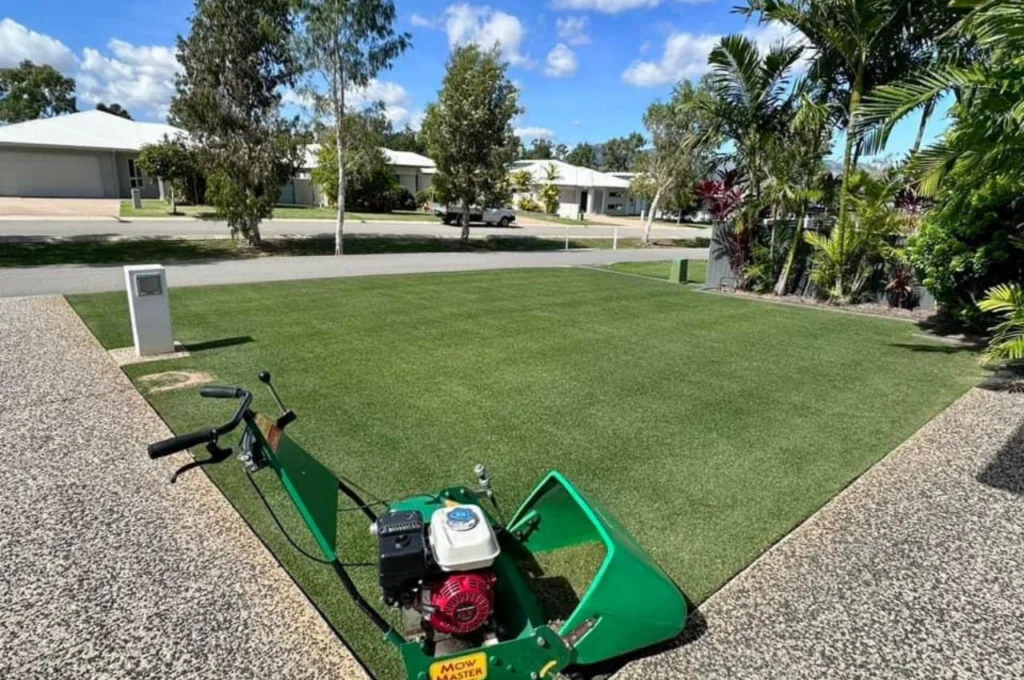
🛠 How To Maintain A Self-Propelled Mower’s Performance
The maintenance required for a self-propelled mower depends on the mower’s power type.
To maintain a self-propulsion mower with a petrol engine, here are some of the tasks required:
Change/top up the fuel
Change/top up the engine oil
Clean the mower after every use
Sharpen the mower blades once or twice a year
Clean/replace the spark plug
Inspect and change the air filters
Lubricate the parts
If you have a self-propulsion mower with a battery-powered electric motor, here are the common maintenance tasks:
Charge the battery as and when needed
Clean the mower after every use
Sharpen the mower blades once or twice a year
Lubricate the parts
Check for/tighten loose nuts, bolts, and screws
As with all the advice in your guide, there may be more maintenance tasks that your specific mower model requires, which we haven’t mentioned here. Consult your user manual for more information.
💰 Are Self-Propelled Mowers Worth It?
Self-propelled mowers are worth it for anyone who has a larger lawn of 400-500m² or bigger.
A mower with a self-propelled drive system can help you to cut your lawn by around 30% to 50% faster compared to using a traditional push mower. Plus, you simply steer the mower and turn it at the end of each lap, so using a self-propelled mower is a lot less of an arm workout.
However, self-propelled models probably aren’t worth it for you if you have a smaller lawn with tight spots and obstacles, which you can probably mow just as fast with a conventional push mower, or you have a small budget and can’t afford the extra expense of self-propulsion.
Regardless of your decision, make sure your new lawn mower is sold by a reputable manufacturer and has plenty of positive customer feedback for performance, durability, and ease of use.
